INTRODUCTION

Over the past 3-4 years we've witnessed an large number of AIO (All In One) liquid CPU coolers get introduced in the market by many of the leading DIY manufacturers that largely thanks to producing better performance levels compared to regular air CPU Coolers and having virtually zero clearance issues with other hardware components are considered to be the best choice for enthusiasts and gamers alike. However although the custom water-cooling market is still considered to be somewhat special (even after all these years) with the summer period reaching its peak (at least in the EU) more and more consumers in general are starting to trust all the latest AIO Liquid CPU cooling solutions (closed loop) since such devices effectively combine good/great performance levels at a fraction of the cost required to get a custom loop (yet higher performance) water-cooling solution. A few months ago Enermax introduced their own AIO liquid CPU Cooler offerings and since from this point forward we will be focusing on water-cooling quite a bit today we will be testing their high end ELC240 model.
Enermax Technology Corporation is a world-renowned PC Power Supply Unit manufacturer. Since our establishment in 1990, we provide power supply products and peripherals like chassis, cooler, fan and keyboard with excellent quality and have won recognitions of consumers around the world. ENERMAX products are recommended by worldwide reviewers, and certain were granted by iF, Red Dot, Good Design and Taiwan Excellence Awards. Those are proven evidence of our top-notch quality and design competency recognized by the professionals. To develop an intensive sales network and better service customers around the world, Enermax has set up branch offices in Germany, France, U.S.A., Japan and China. We also have service offices and distributors in countries across Europe, America, Asia and Oceania. Our farsighted R & D capability is our key strength. The elite teams of Enermax always strive to come up with the best and most satisfactory PSU, thermal solution and peripheral products with cutting-edge design that meets the needs of the market and customers. We will stick to our R & D spirits of “Technology Innovation” and “Quality First” to constantly create products which transcend international standard and requirements to keep up on our product and brand value as well as competitive edge.
As yet another all in one liquid cooling solution the ELC240 consists by a large 32mm thick radiator connected to a "portable" ceramic bearing pump with the help of two thin 315mm long fluorinated ethylene propylene tubes and two 120mm Twister bearing technology fans offering a total of three integrated speed control modes. So by looking at the ELC240 it doesn't really stand out from all the other 240mm AIO solutions in the market currently, what is however somewhat intriguing is that compared to most rival solutions that are manufactured by Asetek or CoolIT Enermax has chosen a whole different path and decided to sign up with AVC (Asia Vital Components) for the design, development and manufacture of their AIO liquid CPU coolers. AVC has been around for slightly over a decade and is considered to be one of the world's leading Thermal Solution providers and since I’ve worked with them in the past I’m somewhat curious as to what they have cooked with Enermax so let's move forward to the rest of our ELC240 AIO Liquid CPU Cooler review.
SPECIFICATIONS AND FEATURES

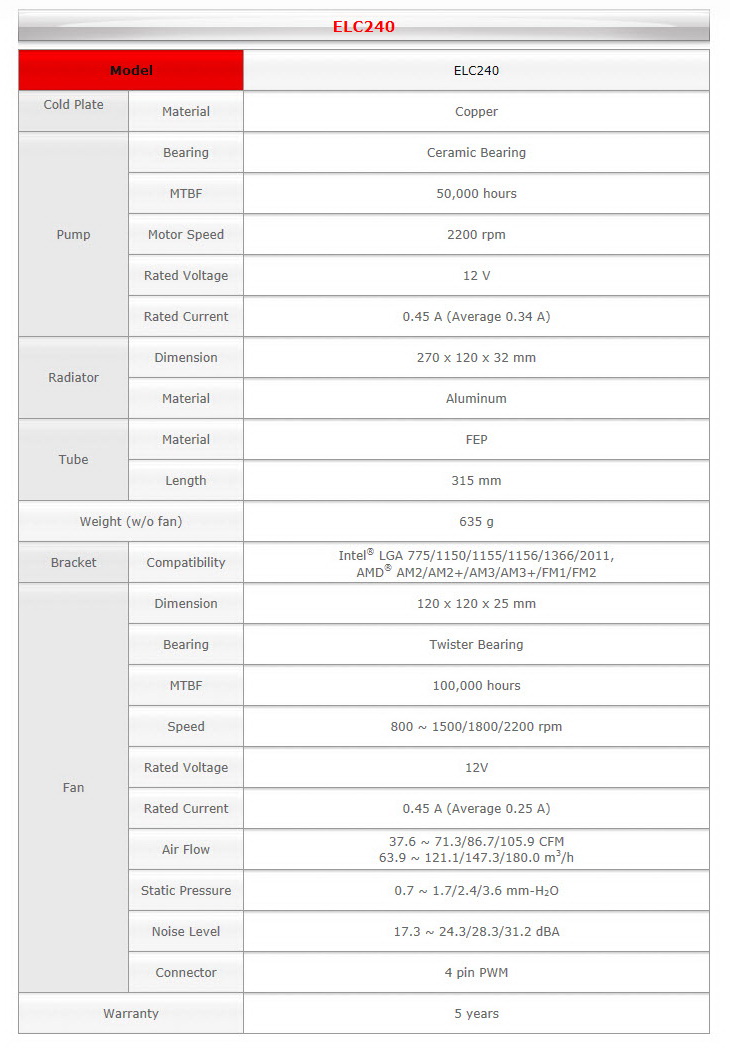
PACKAGING AND CONTENTS
At the top of the box Enermax has placed a large product image, the socket compatibility list and the three main features of the product.
The front end includes the features list and showcases some of these features with 4 medium sized images.
Some words about the product printed in 12 languages are present at the rear of the box right above the bundle contents list.
Finally at the bottom of the box we see a detailed specifications list placed alongside a performance chart and a drawing showcasing the dimensions of the ELC240.
As you can see Enermax stores the ELC240 inside a formed piece of cardboard that keeps it safe during transport.
In the box you will find pretty much everything you'd need to install the ELC240 including the main radiator/pump body, two 120mm fans, user’s manual, 5 small plastic bags with all the necessary screws and bots, 8 rubber pads, an Intel backplate and two brackets for Intel LGA775/1155/1156/1366/2011 and AMD AM2/AM2+/AM3/AM3+/FM1 mainboards.
THE ELC240
The main body of the ELC240 is made by an 270mm long, 120mm wide and 32mm thick radiator that can accommodate up to four fans in push & pull configuration.
We have seen thicker 240mm radiators in the market but we've also seen quite thinner ones so Enermax has hit a good balance.
Worth mentioning is that the radiator fins are perfect and I’m putting extra weight in this cause with most AIO solutions this is not the case (we've seen bend ones with several other samples).
The 315mm long fluorinated ethylene propylene tubes are made by a harder material than what we see on other solutions still they are almost equally flexible.
Enermax has opted for a normal printed logo instead of a LED light ontop of the small ceramic bearing pump (2200RPM).
Aside being quite flexible the tubes can also be rotated at the pump giving the consumer even more flexibility.
Under the pump Enermax has pre-applied thermal paste to the copper cold plate but unfortunately there are quite a few marks/scrapes on the copper which we hope will not affect our outcome.
To power the pump Enermax has placed a single cable with three 4pin connectors one that takes power directly from the motherboard (and also sends info like current RPM and temperatures) and two others on which you can connect the two 120mm fans (although personally i prefer connecting fans onto the mainboard or a separate fan controller).
The bundled fans are controlled via a small switch placed at their rear which allows for speeds between 800-1500RPM, 800-1800RPM and 800-2200RPM (in our tests we used the top mode).
With the fans installed on the radiator the width increases from 32mm to 57mm so you need to take it into account when installing the ELC 240.
TEST BED


TESTING METHODOLOGY
We always take things quite seriously when it comes to work so just like with the previous LGA1366 database we will not be testing each CPU Cooler on its own and with different ambient temperature levels and thus we can actually have yet another valid CPU Cooler database. Testing a CPU Cooler automatically means that you need to know where it stands against the immediate competition and to accomplish that we have spent both money and time through the years, something that we plan to continue to do so in order to get the most accurate results for the end consumers who read these lines. Every CPU cooler in this database is tested with the bundled 140mm/120mm/92mm/80mm fans while working at both idle speed and 100% of their speeds for all the temperature tests. CPU Coolers that do not come bundled with a fan/s are measured using a Noctua fan (size dependent on the model) to test for the temperature tests but due to the lack of a stock fan dBA level tests are obviously skipped. For the dBA tests every cooler in the database was measured both while on idle mode or with the fan controller in the minimum setting and while on extreme load or with the fan controller all the way to the highest possible setting (PWM fans do that on their own without our intervention). Every single test takes place in a temperature controlled room of 23 degrees Celsius Ambient Temp with the help of two AC units placed diagonally inside the room. The Arctic Silver 5 thermal paste is used with every CPU Cooler in our latest LGA2011 database (although initially this was not the plan we had to change things to get the most accurate results). Finally it's very important to point out that just because a CPU Cooler is better than another when tested with our Intel Core i7-3930k test rig that does not necessarily mean that the same performance differences will apply 100% for other CPU models and in other situations (such as different ambient temps and system configurations).
To successfully record the load temperatures we use the latest OCCT application for around 6-10 minutes to push the processor to its limits and after that is done and the temperatures are recorded we wait for about 10-20 minutes for the CPU to cool down and record the idle temperatures. This is done to allow time for the thermal conductive material to achieve the optimal performance level. Same procedure is then repeated with the Passmark BurnIn Test as a failsafe just in case the OCCT results are wrong. This procedure takes a lot more time than the usual peltier/thermometer tests but this way not only can we deliver real world results to our readers based on real CPUs but we can also triple check the results using a variety of programs. Last but not least the temperatures were recorded using both the latest versions of AIDA64 and RealTemp while the noise level tests are performed using a high precision ExTech HD600 Decibel Meter placed about 10-15cm above the CPU Cooler. Still although the same testing procedure applies to all units do take into consideration that unlike the official numbers which are measured in special noise isolated labs with just the fans here we also have both the rest of the cooler and the rest of the system (although all system fans are turned off when recording noise levels).
Since many of you have asked when it comes to AIO liquid CPU Coolers (and water-cooling in general) we install the radiator either at the rear (120mm solutions) or at the top (240mm+ solutions) with the fans pointing outwards (exhaust mode) since that's where the majority of the PC Cases in the market have room for radiators. However if you happen to own one with a front radiator spot then we recommend mounting it there instead (cold air entering and passing directly from the radiator is preferred) for better performance.
TEST RESULTS
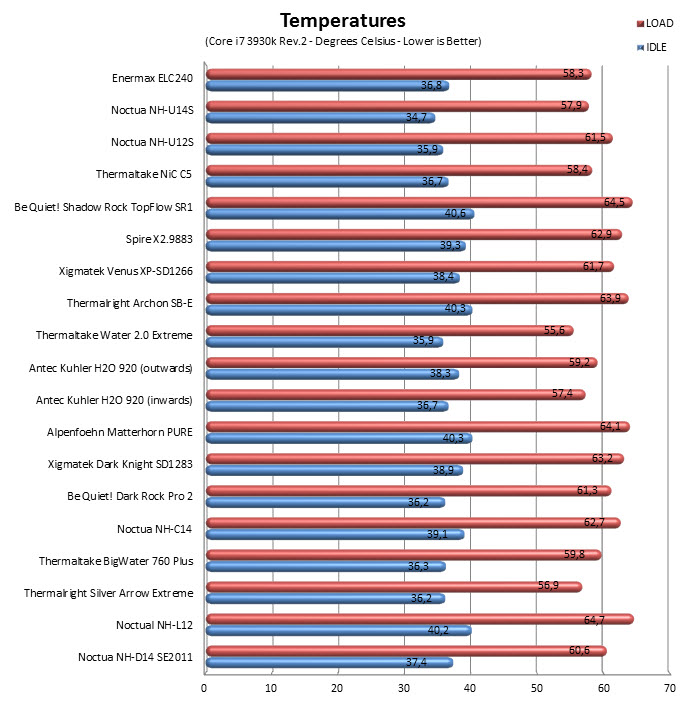

CONCLUSION

Although Enermax is amongst the top PSU manufacturers currently they haven't really been focusing on CPU Cooling for that long and although plain CPU Coolers are not that hard to develop and produce the same doesn’t apply for AIO liquid CPU coolers. So originally when we heard that Enermax was planning to release their own AIO liquid CPU Coolers we naturally thought that just like Antec, Corsair and others they'd also pick either Asetek or CoolIT for the job. Instead Enermax went and surprised us all by picking AVC and although we are talking about a manufacturer with at least 10 years of expertise surrounding thermal/cooling solutions still no one here had the slightest idea as to how their solution would perform. Well after several hours of testing the results are mixed and so although the performance of the ELC240 comes really close to the Water 2.0 Extreme by Thermaltake still it does fall behind as it does against the top CPU Air Cooler by Noctua the NH-U14S. Still there's one thing that you all need to take into account regarding our test rig and that's that it has tons of airflow something not every PC Case out there has so naturally heatsink based coolers work a lot better here. Also if you happen to have a PC Case with a front mounting spot for a 240mm radiator then by placing the ELC240 there you should notice a bump in performance. Noise levels are perhaps the only issue of the ELC240 along with the fan speed control switches which are not placed at the easiest location so if you want to switch from low to mid and high speeds it will take some time.
With a price tag currently set at USD131.71 inside the USA (Amazon.com) and 115Euros inside the EU (Amazon.co.uk) the Enermax ELC240 AIO Liquid Cooling Solution lands right between the equally large Hydro 110 by Corsair and the quite larger Kraken X60 by NZXT. Now since i haven't tested these two solutions on our primary test rig (yet) in order to have a complete picture i will not comment in terms of performance, however Corsair does have a longer history with AIO liquid CPU Coolers so i expect most people to choose their solution instead. That being said the ELC240 AIO by Enermax may not be the cooling efficiency king but it works as it should with good performance levels, has room for improvement (two more fans in push & pull), can be installed very easily and in the process you get no clearance issues with other system components. Of course both the price issue (compared to its immediate competition) along with the fact that you can't control the speed of the fans from the comfort of your desktop remain but still thanks to all of the above it still gets highly recommended and gets our Golden Award.

PROS
- Build Quality
- Good Cooling Efficiency
- Easy Installation
- Zero Clearance Issues
CONS
- Price (For Some)
- Fan Selection Switch (Hard To Reach)

 O-Sense
O-Sense















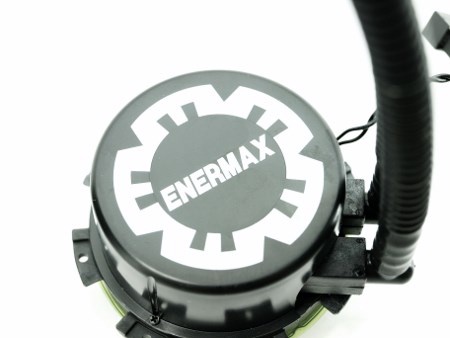
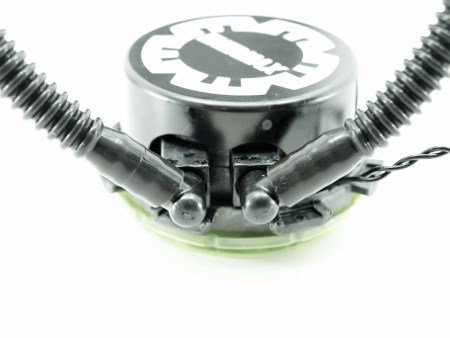





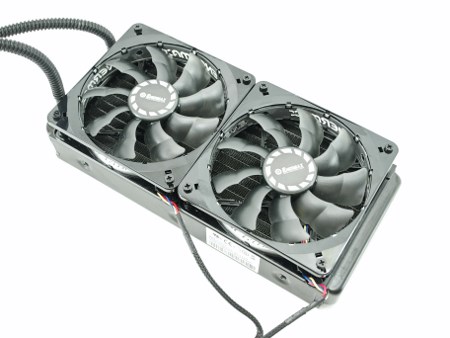


.png)

